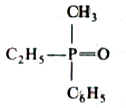Which of the following is chiral?




The correct Answer is:B, C, D
To determine which of the given options is chiral, we need to follow these steps:
Step 1: Understand the Definition of Chirality
A chiral molecule is one that cannot be superimposed on its mirror image. A chiral center (often a carbon atom) must have four different substituents (or groups) attached to it, and it should not have any double bonds.
Step 2: Analyze Each Option
We will analyze each option to see if it contains a chiral center.
Option 1:
- Molecule: Contains phosphorus.
- Analysis: Phosphorus is bonded to four different groups, but it has a double bond with oxygen. Since it has a double bond, it cannot be considered chiral.
Option 2:
- Molecule: Contains sulfur.
- Analysis: Sulfur is bonded to four different groups, but it also has a double bond with oxygen. Thus, it cannot be considered chiral.
Option 3:
- Molecule: Contains nitrogen.
- Analysis: Nitrogen is bonded to four different groups: methyl, ethyl, phenyl, and hydrogen. There are no double bonds present, so this molecule can be considered chiral.
Option 4:
- Molecule: Contains sulfur.
- Analysis: In this case, sulfur is bonded to two identical groups. Since two groups are the same, this cannot be a chiral center.
Step 3: Conclusion
After analyzing all the options, we find that Option 3, which contains nitrogen with four different substituents and no double bonds, is the only chiral molecule.
Final Answer:
The chiral molecule is Option 3.
---
A chiral molecule is one that cannot be superimposed on its mirror image. A chiral center (often a carbon atom) must have four different substituents (or groups) attached to it, and it should not have any double bonds.
We will analyze each option to see if it contains a chiral center.
- Molecule: Contains phosphorus.
- Analysis: Phosphorus is bonded to four different groups, but it has a double bond with oxygen. Since it has a double bond, it cannot be considered chiral.
- Molecule: Contains sulfur.
- Analysis: Sulfur is bonded to four different groups, but it also has a double bond with oxygen. Thus, it cannot be considered chiral.
- Molecule: Contains nitrogen.
- Analysis: Nitrogen is bonded to four different groups: methyl, ethyl, phenyl, and hydrogen. There are no double bonds present, so this molecule can be considered chiral.
- Molecule: Contains sulfur.
- Analysis: In this case, sulfur is bonded to two identical groups. Since two groups are the same, this cannot be a chiral center.
After analyzing all the options, we find that Option 3, which contains nitrogen with four different substituents and no double bonds, is the only chiral molecule.
The chiral molecule is Option 3.
Similar Questions
Knowledge Check
Which of the following is a chiral molecule?
A1-chloro propaneB2-chloro propaneC1-chloro butaneD2-chloro butaneWhich one of the following is chiral ?
A1, 1-Dibromo-1-chloropropaneB1,3-Dibromo-1-chloropropaneC1, 1-Dibromo-3-chloropropaneD1, 3-Dibromo-2-chloropropaneWhich of the following dienes is chiral?
ACH3−CH=C=CH2BCH3−CH=CH−CH=CH2CCH3−CH=C=CH−CH3DCH2=CH−CH2−CH=CH2



